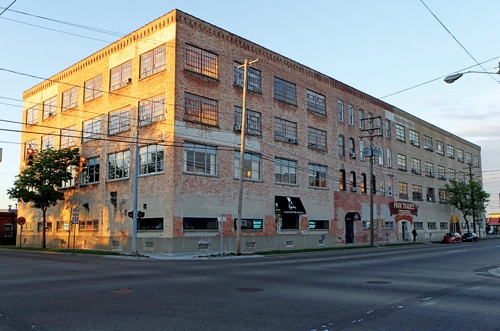Artists and artisans flock to the Park Trades Center in search of a space to create and be inspired.
The 140,000-square-foot building on Kalamazoo Avenue contains four floors, housing about 95 studio spaces occupied by artists working in a variety of mediums including glass art, papermaking, metalsmithing and textiles.
But there are also artisans like Tim Hills, who owns Trystcraft, a business focused on the repair and restoration of furniture made between 1945 and 1975, especially Danish modern pieces.
Hills said he learned about the Park Trades Center after attending Art Hop, a monthly multi-venue art event in the downtown Kalamazoo area. He said the building appealed to him because of the wide variety of skills, crafts and artists displayed there.
“I was looking for a place that allowed me to have a workshop and storage space and was relatively centrally located near the city center,” Hills said. “I sell most of my stuff online and ship out nationally and internationally.”
While a loading bay and dollies may not seem like amenities, these are important elements of the building to a craftsman like Hills who works with large pieces. He also appreciates having other artisans nearby, because he’s able to benefit from their skills and expertise.
The presence of such an artist’s collective affirms the fact that the Kalamazoo area is a culturally rich environment, said Kristen Chesak, executive director of the Arts Council of Greater Kalamazoo.
“The (Park Trades Center) removes the accessibility barrier and gives exposure to so many different art forms and ways to express yourself,” Chesak said.
However, when the building was first constructed in the early 1900s, it was done so with a very different use in mind.
Lynn Houghton, Kalamazoo’s resident historian, said the building began as the headquarters for the Kalamazoo Loose Leaf Ledger Company, which opened in 1903. She said other tenants throughout the years included the Remington-Rand Company, a business machine manufacturer, and the Saniwax Company, which made wax paper products. After undergoing several expansions, the last one in 1921, the building grew to its present size.
Houghton said she was never able to pinpoint exactly when the building morphed into a haven for artists.
“It was during the 1970s that we saw groups of artists and craftspeople start renting space, after Saniwax left in 1971,” Houghton said. “For the last 46 years, it’s been filled with a variety of artists and craftspeople.
“This building has been continuously open since 1906. It’s never been vacant, which is atypical.”
Chesak said the Park Trades Center’s current identity is an asset not only to the artists, but to the entire community. She said national studies have shown that close to 73 percent of businesses nationally give to the arts and 76 percent of their employees are connected in some way to the arts.
Many of those who have spaces in the Park Trades Center may be bankers or teachers during the week, and don their artist hats on the weekends.
“It’s really important for a healthy community to have those creative outlets,” she said.
The fact that the building was used for so many years as dedicated factory space has given the artists who occupy studios there the opportunity to turn nooks and crannies into individual creative spaces, according to Chesak.
“It confirms commonalities when you see so many art forms in one place,” she said. “There’s an energy in that space that you can’t replicate in terms of how the artists feed off of each other. It creates an atmosphere of continuous learning in terms of personal and professional development.”
Rogelio Almaguer, owner of Manifold Art Studios, which occupies 1,000 square feet of space in the Park Trades Center, said he currently shares the studio with a graphic designer, an industrial engineer and an apprentice.
During his sophomore year at Kendall College of Art and Design, Almaguer wanted to have a large studio space of his own to work in. The Park Trades Center appealed to him because it wasn’t a typical commercial space. In March, he moved in and began his tattoo and drawing business, while also providing space for artists working in other mediums.
“I didn’t want it to be a tattoo shop — I wanted it to be more of a private studio where I could spend time with my clients and really get to know them,” Almaguer said. “I focus more here on tattoo, but I also do freelance work and illustrations on the side.”
One of the artists who shares space with him is currently working on a project for PUMA and another is doing design work for Merrell, best known for its line of outdoor footwear.
“When I’m tattooing, I may have someone else in here painting or drawing,” Almaguer said. “More than anything for me, it’s the inspiration. Everybody brings something different to the table and has something special within them. It’s having that group of people you can feed off of.”





